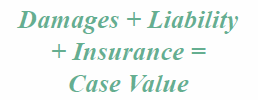
How much will my personal injury case settle for?
Your personal injury settlement’s value is based upon three key items: damages, liability and insurance.
Damages
The most important key variable in your settlement amount is damages. Damages are best described as the injuries you suffered as a result of another party’s actions. For example you get rear-ended by someone and sustain herniations or bulges in your back and neck. You’re at work and you fall off a ladder and break your leg. You slip and fall on a wet grocery store floor where they have no signs and you break your arm. You get surgery and the doctor operates on the wrong side of your body.
These damages need to be treated until you reach maximum medical improvement. Treatment takes time and money and should be paid for by the at-fault party in the form of a settlement.
Damages also include missed time from work. You may miss work after being in an accident because you’re in too much pain to work, your injuries prevent you from doing your job properly or your employer fires you.
If you don’t have any damages, have injuries, but aren’t treating for them you will have a hard time collecting any substantial settlement.
Liability
The next variable in your settlement calculation is liability. Who is at fault for your personal injuries? In a rear-end auto accident, liability is clear cut. The person who rear-ended you with their car is always at fault because they are obligated to keep a safe distance from the car in front of them.
Liability in other cases isn’t always cut and dry. The accident may partially be your fault. If liability is shared it is up to the insurance companies to determine what percentage of fault each driver has. If the accident is primarily your fault it will be more difficult to settle for damages.
Insurance
Insurance is the final variable in your settlement value. What sort of insurance coverage does the at fault party have? Most people who drive, own businesses, own stores or practice medicine buy insurance to transfer risk from themselves to the insurance company. They pay premiums periodically and the insurance company agrees to pay settlements if their actions result in the injury of others.
The insurance company can only pay out a settlement up to the limit that the policy allows for. For example if you sustain damages of $100,000 and the insurance coverage limit is only $50,000, you cannot receive more than a $50,000 settlement. However, if they insurance coverage limit is $1,000,000 and your damages are only $10,000 you will not receive a $1,000,000 settlement.
Attorney Fees and Other Liens
While attorney fees are not in our “settlement value = damages, liability, and insurance” calculation, they are important to consider. Personal injury attorneys usually work on a contingency basis, which means they only get paid from the settlement proceeds if the case is successful. A typical contingency fee is 33% for a case that settles outside of court and 40% for a case that goes to trial. For example if your case settles for $30,000, then your attorney would receive $10,000.
Other liens include medical liens, where treatment for your injuries is reimbursed from the settlement. If any child support liens exist they must be paid from the settlement before you receive any money. If you borrowed any money against your case it must also be repaid with fees, from your settlement.
Estimating Your Settlement
If you want to get an idea for what you’ll receive in your settlement then add up your damages, account for liability and insurance limits. Then subtract your attorney’s contingency fee and any other liens against your settlement.
Maximizing Your Settlement
If you want to maximize the amount of money you receive in your lawsuit settlement the most important thing you can do is treat for your injuries. Treating for your injuries is where most of the damages come from. You won’t know the value of your damages until you finish treating and reach maximum medical improvement. Of course it’s hard to be repaid for your treatment if the at-fault party is not found liable or they have little or no insurance coverage.
Another way to maximize your settlement is to not accept the first offer from an insurance company. Insurance companies are experts at dealing with claims and will do everything in their power to delay, deny and defend yours.
Insurance companies understand that after an accident you may be out of work and in pain. Insurance companies know most victims in personal injury cases are in financial distress, which is why their first settlement offer is usually a low-ball one.
If you have a personal injury case and need cash to cover expenses you don’t have to accept the insurance company’s first offer. You can maximize the value of your case with a pre-settlement advance. A pre-settlement advance allows you to get by the in short-term until you get back to work or until your case settles. A pre-settlement advance puts you on a level playing field with the insurance company. Pre-settlement advances are non-recourse and you only have to repay them if and when your case settles. They are repaid from your case’s settlement proceeds just like any other lien.
To learn more about pre-settlement advances give us a call or apply online. We will give you an estimate of how much your personal injury case will settle for and offer you a pre-settlement advance of up to 10% of that estimate.

